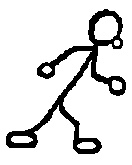About Us
Vishwawalking explained
 Ratings Explained
Ratings ExplainedVishwawalks
Parks, etc. walks
Funky Places
Future walks
Food
Gear
Get Lost
Good reads
Links
Right to Ramble
Site map
Contact us
Point Pelee National Park of Canada
I have yet to walk and report on this site. However (for reasons listed below), spring seems to be the most opportune time. Meanwhile, the information below should be helpful for walkers.***
This is one of Canada's smallest national parks. It is made up of 15 square kilometres and is seven kilometres long and 3.5 kilometres wide at the northern part, tapering to a point in the south.
The park has 12 kilometres of "self-guided trails." There are 8 trails, the longest being four kilometres. Several are loop trails.
See the box below for information on temporary spring birding paths.
The park is the northernmost point of the "Carolinian zone." Lake effect and its southern location make it unusually warm for Canada, with an average yearly temperature of 8 degrees centigrade (46 Fahrenheit). Its unusual temperature makes it home to more unusual plants and animals than any other place in Canada.
It was made into a park in 1918. Commercial fishing went on in the park until 1969 and duck hunting was allowed until 1989.
The tip of the park is the most southern point on the Canadian mainland (The most southern point is Middle Island, which belongs to the park. It's to the south of Pelee Island. Middle Island is closed from March 1 to September 1, to protect nesting birds and endangered plants. However, nesting cormorants are presently destroying the ecosystem there and Parks Canada is taking steps to prevent this..
Friends of Pelee Park home page. The friends run a little café in the park (Catttail Cafe at the Marsh boardwalk), which is an unusual amenity for a provincial or federal park. Proceeds go to keep up the park.
Point Pelee is known internationally as a migratory stopping-off point for birds, and bird-watchers flock to its shores. There are scheduled birdwatching hikes and there is a festival of birds every spring.
It's also a stop for monarch butterflies. Best viewing times are between August and early October, with a peak in September. However, times vary with weather conditions. The Parks Canada website recommends you watch out for cool nights with cold fronts. In September they have a special infoline you can check (with a recorded message): 519-322-2371.
A map of the park with great detail maps of trails and paths will give you an idea of what's possible. The Parks Canada site for Point Pelee is a must for any informed park visitor. It's packed with info.
Paths for birdwatchers: protected footpathsTake care when you walk through Pelee Park.There are special paths that are open only in the spring. There are no legal restrictions on anybody actually walking the trails at any time. However, I'd strongly recommend walkers play by the rules. That way we preserve the flora and fauna and we get a better park to walk through. Here's a 2006 excerpt from the warden of the park (see the full report at the Outbirds posting site) "For
more than twenty years the park has provided a network
of seasonal
footpaths identified by a circular blue sign with a
Cardinal illustration.
Each year after the spring birding season, these signs
were removed,
leaving seasonal footpaths unmarked to allow for
re-vegetation. Octagonal
stop sign shaped signs, with a boot illustration and
the message ‘No Entry
- Protect Pelee’s Plants’, were posted in locations
where vegetation was
impacted to discourage visitor use. Ongoing vegetation
and visitor use
monitoring, as well as physical changes particularly
in the Tip area due to
erosion factored into the determination of routes and
which seasonal
footpaths were opened from year to year.
In 2005, as part of a pilot project, signs within Point Pelee National Park were redesigned and replaced to meet Canada’s Federal Identity Program requirements and universal visitor information/safety standards. As a result, the ‘Cardinal’and ‘No Entry - Protect Pelee’s Plants’ signs were retired. The new signs, first installed Spring 2006, use the hiker/walker symbol with text and are intended to complement one another. The green rectangular sign, with the hiker/walker symbol within a blue square and the message ‘Seasonal Footpath’, is posted the beginning of the spring birding season to mark seasonal footpaths. The other, the green rectangular sign with the hiker/walker within the red circle symbol indicating no entry with the message ‘Protect The Plants’, replaces it after the spring birding season to discourage visitor use of the seasonal footpaths. |
External links to pages about Point Pelee:
Point Pelee National Park of Canada (Parks Canada site)
Wikipedia page
DDT at Point Pelee (a resource for teachers, this site chronicles past use of pesticides in the park and efforts to clean up contaminated areas).
A Canadian Geographic article describes Pelee Point past and present. In the not-so-distant past, it was a favorite place for teenagers to lay some rubber and relax on the beach. Pesticide use was rampant (to reduce, among other things, pesky mosquitoes) and buildings were scattered along the point.
How to get there: Point Pelee is on Lake Erie, just south of the town of Leamington. From Highway #401, watch for the park signs at exit #48. This gets you onto Highway #77. Head south, winding through Staples, then straight through Blythwood and Mount Carmel for 24 kilometres to Leamington, where #77, at Talbot Street, turns into Erie Street. Keep straight down Erie for 2 kilometres to Seacliffe (County Road #20), where you'll turn left. At just over a kilometre, angle right at Bevel Line (County Road #33). Drive for six kilometres to the park gates. (Bevel turns into Robson and runs along the shore just before you reach the park gates.) Park signs will help you find your way. The Parks Canada beaver sign should also keep you on the right road.
Back to the main Canada's National Parks page